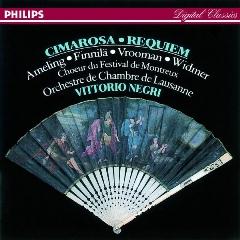Cimarosa – Requiem (Vittorio Negri) [2012]
Cimarosa – Requiem (Vittorio Negri) [2012]

1 Introitus: Requiem - Kyrie - Tractus 11:35 2 Sequentia: Dies Irae - Tuba Mirum - Mors Stupebit - Judex Ergo - Rex Tremendae 6:16 3 Recordare 5:22 4 Ingemisco 2:41 5 Preces Meae 3:06 6 Inter Oves 6:22 7 Lacrymosa 6:02 8 Domine Jesu 4:37 9 Sanctus 2:10 10 Benedictus 2:41 11 Agnus Dei 1:51 12 Lux Aeterna 7:08 Elly Ameling – Soprano Birgit Finilla - Contralto Richard Van Vrooman – Tenor Kurt Widmer - Bass Montreux Festival Chorus Lausanne Chamber Orchestra Vittorio Negri – Conductor
Composed only a few years before Mozart's own unfinished Requiem, it invites invidious comparisons, being essentially a "pièce d'occasion" composed in haste for the funeral of the wife of the ambassador of Naples and Sicily who unexpectedly died a few days after Cimarosa's arrival in St Petersburg at the invitation of Catherine the Great. It contains very little to stir the blood, least of all where you might expect it in the "Dies Irae"; the main interest lies in its rarity and the contribution of the bell-voiced Elly Ameling, especially in her slightly unusual "Tuba mirum", which has no "tuba", only two horns. The alto has a pleasantly smoky tone but is rather placid in manner. Things perk up in the "Recordare" where their duet sounds like a definite rip-off from the Pergolesi "Stabat Mater". The tenor makes a strange, grainy, mixed-falsetto sound and despatches his "Preces meae" neatly in this most operatic section. The bass is really a baritone; he has no low notes. The writing mainly features very conventional chordal progressions and stock ideas such as the obligatory "Amen" fugue in the "Lacrymosa". The orchestral playing is alert, the choir likewise, the sound good for 1969 with the voices rather prominent. ---Ralph Moore, amazon.com
Neapolitan composer Domenico Cimarosa started out as a church musician, but made his name in opera. His skills earned him court appointments, and one of them, in the mid-1780s, from Catherine the Great of Russia. It was for her court, to memorialize a deceased French ambassador, that this Requiem in G minor for soloists, chorus, and orchestra was composed in 1787. Taken for what it is, without expectation that it will much resemble Mozart's or Haydn's church music, it's an attractive work even if it's a trifle inadequate to its subject. The package blurb promises "vivid evocations" of the day of wrath and other such riches, but the music contains nothing of the sort. Instead you get some pretty rudimentary choruses surrounding some very operatic arias where you sense that Cimarosa was in his element. Most of them offer long, sustained melodies that can hold their own with the solos in Mozart's Vesperae solennes de confessore, K. 339, and other choral music of the period.
Mozart might easily have had this or other requiem settings in his head when composing his ultimate masterpiece, and anyone curious about Cimarosa's sacred output can be encouraged to give this album a try. ---James Manheim, Rovi
download (mp3 @320 kbs):
yandex 4shared mega mediafire zalivalka cloudmailru uplea








